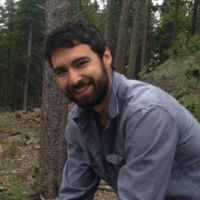Bandler, et al., 2015
Aspect Controls on Bedrock Fracturing and Seismic Velocity within the Boulder Creek Critical Zone Observatory
Bandler, A., Magill, C., Hendricks, S., and Singha, K. (2015)
H51R-06 Hydrogeophysical Characterization of the Critical Zone I, presented at 2015 Fall Meeting, AGU, San Francisco, CA, 14-18 Dec.
-
Boulder, GRAD STUDENT
-
Boulder, Shale Hills, INVESTIGATOR
Abstract
We investigate the controls of slope aspect on groundwater flow and geomorphic weathering within the Boulder Creek Critical Zone Observatory by studying the orientation and density of bedrock fracturing. Based on a series of seismic refraction surveys, we compare the seismic velocities and anisotropy of the subsurface soil and regolith with the distribution of fractures observed in 7 geophysical borehole logs. Conflicting hypotheses exist as to whether bedrock fracturing, and thus hydraulic conductivity, is controlled more by the regional tectonic stress field or by slope aspect. We examine bedrock fracturing on north- and south-facing slopes via the relationship between fracture orientation and seismic velocity, and find that our south-facing slope demonstrates pronounced seismic anisotropy, with velocities of up to 2,000 m/s in the E-W direction, and approximately 1,000 m/s in the N-S direction. By contrast, the north-facing aspect demonstrates no significant anisotropy, with velocities ranging from approximately 800-1,500 m/s. Similarly, borehole logs show conjugate sets of fractures on south-facing slopes striking in a general E-W direction, while north-facing borehole data reveal a high density of fracturing with less pronounced directional dependence. Based on current models of hillslope weathering, we interpret the slower and more isotropic velocities of the north-facing slope to be a more random orientation of fractures, caused primarily by more intense weathering processes. On the south-facing slope, we interpret the conjugate fracture sets and pronounced anisotropy to be fracturing resulting from tectonic stress. Assuming that both slopes experience similar tectonic stress, results suggest that slope aspect controls weathering and groundwater flow, and north-facing slopes demonstrate a more advanced state of weathering.
Citation
Bandler, A., Magill, C., Hendricks, S., and Singha, K. (2015): Aspect Controls on Bedrock Fracturing and Seismic Velocity within the Boulder Creek Critical Zone Observatory . H51R-06 Hydrogeophysical Characterization of the Critical Zone I, presented at 2015 Fall Meeting, AGU, San Francisco, CA, 14-18 Dec..
Explore Further


